
Arabic_for_Dummies
.pdf
46 |
Part I: Getting Started |
In order to conjugate the verb baa’a in the present tense, use the form yabi- i’u (yah-bee-ooh; to sell).
Form |
Pronunciation |
Translation |
‘anaa ‘abii’u |
ah-nah ah-bee-ooh |
I am selling |
‘anta tabii’u |
an-tah tah-bee-ooh |
You are selling (MS) |
‘anti tabii’iina |
an-tee tah-bee-ee-nah |
You are selling (FS) |
huwa yabii’u |
hoo-wah yah-bee-ooh |
He is selling |
hiya tabii’u |
hee-yah tah-bee-ooh |
She is selling |
naHnu nabii’u |
nah-noo nah-bee-ooh |
We are selling |
‘antum tabii’uuna |
an-toom tah-bee-oo-nah |
You are selling (MP) |
‘antunna tabi’na |
an-too-nah tah-beeh-nah |
You are selling (FP) |
hum yabii’uuna |
hoom yah-bee-oo-nah |
They are selling (MP) |
hunna yabi’na |
hoo-nah yah-bee-nah |
They are selling (FP) |
antumaa tabii’aani |
an-too-mah tah-bee-ah-nee |
You are selling |
|
|
(dual/MP/FP) |
humaa yabii’aani |
hoo-mah yah-bee-ah-nee |
They are selling |
|
|
(dual/MP) |
humaa tabii’aani |
hoo-mah tah-bee-ah-nee |
They are selling |
|
|
(dual/FP) |
For the future tense, simply add the prefix sa- to the present form to get sayabii’u (sah-yah-bee-ooh; he will sell).
Form |
Pronunciation |
Translation |
‘anaa sa’abii’u |
ah-nah sah-ah-bee-ooh |
I will sell |
‘anta satabii’u |
an-tah sah-tah-bee-ooh |
You will sell (MS) |
‘anti satabii’iina |
an-tee sah-tah-bee-ee-nah |
You will sell (FS) |
huwa sayabii’u |
hoo-wah sah-yah-bee-ooh |
He will sell |
hiya satabii’u |
hee-yah sah-tah-bee-ooh |
She will sell |
naHnu sanabii’u |
nah-noo sah-nah-bee-ooh |
We will sell |
‘antum satabii’uuna |
an-toom sah-tah-bee-oo-nah |
You will sell (MP) |
‘antunna satabi’na |
an-too-nah sah-tah-beeh-nah |
You will sell (FP) |

|
Chapter 2: The Nitty-Gritty: Basic Arabic Grammar |
47 |
|
|
|||
Form |
Pronunciation |
Translation |
|
hum sayabii’uuna |
hoom sah-yah-bee-oo-nah |
They will sell (MP) |
|
hunna sayabi’na |
hoo-nah sah-yah-bee-nah |
They will sell (FP) |
|
antumaa satabii’aani |
an-too-mah sah-tah-bee-ah-nee |
You will sell |
|
|
|
(dual/MP/FP) |
|
humaa sayabii’aani |
hoo-mah sah-yah-bee-ah-nee |
They will sell |
|
|
|
(dual/MP) |
|
humaa satabii’aani |
hoo-mah sah-tah-bee-ah-nee |
They will sell |
|
|
|
(dual/FP) |
|
Here are some other common irregular verbs:
waSala/yaSilu (wah-sah-lah/yah-see-loo; arrived/to arrive)
zaara/yazuuru (zah-rah/yah-zoo-roo; visited/to visit)
mashaa/yamshii (mah-shah/yam-shee; walked/to walk)
‘ishtaraa/yashtarii (eesh-tah-rah/yash-tah-ree; bought/to buy)
radda/yaruddu (rah-dah/yah-roo-doo; answered/to answer)
jaa’a/yajii’u (jah-ah/yah-jee-ooh; came/to come)
ra’aa/yaraa (rah-ah/yah-rah; saw/to see)
‘a’Taa/yu’Tii (ah-tah; yah-tee; gave/to give)
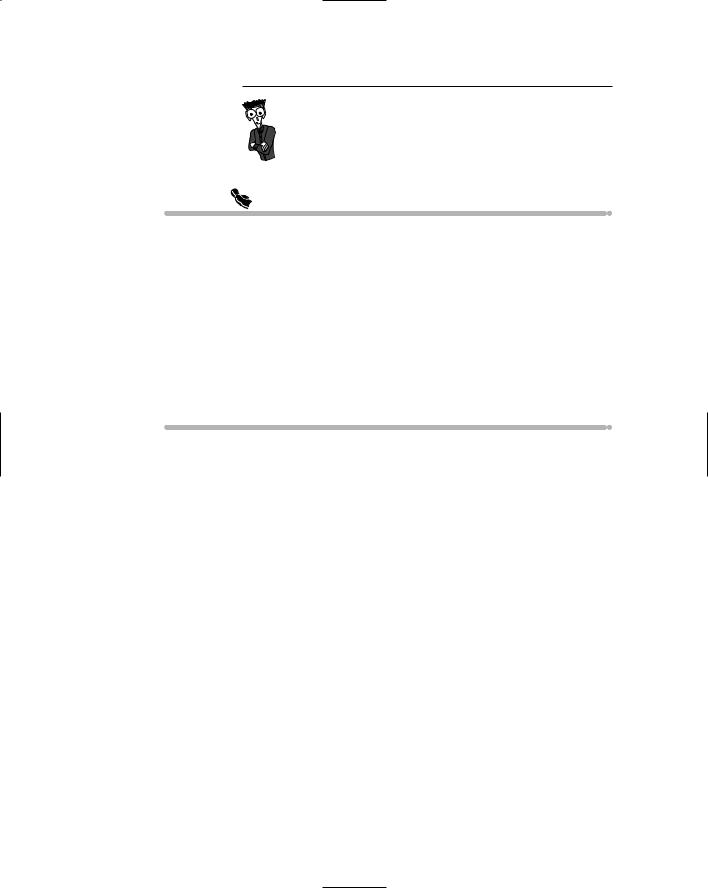
48 |
Part I: Getting Started |
 Fun & Games
Fun & Games
Match the personal pronouns on the left column with their Arabic equivalents on the right.
you (MS) |
huwa |
we |
‘anta |
they (FP) |
‘anaa |
you (FS) |
naHnu |
he |
‘anti |
I |
hunna |
The answers are in Appendix C. |
|

Chapter 3
‘as-salaamu ‘alaykum!: Greetings and Introductions
In This Chapter
Handling pleasantries
Using common introductions
Referring to countries and nationalities
In Arabic culture, you can’t underestimate the importance of greetings. First impressions in the Middle East are crucial, and knowing both the
verbal and nonverbal nuances of greeting people is one of the most important aspects of mastering Arabic.
In this chapter, I show you how to greet people in Arabic, how to respond to basic greetings, and how to interact with native Arabic speakers. You find out when it’s appropriate to use formal and informal terms, how to make small talk, and how to introduce yourself. HaDHan sa’iidan! (had-dan sa-ee-dan; Good luck!)
Greetings!
In Arabic, you have to choose between formal and informal ways of greeting people. The greeting you use depends on whom you’re addressing: If you’re greeting someone you don’t know for the very first time, you must use the more formal greetings. On the other hand, if you’re greeting an old family friend or a colleague you know well, feel free to use the more informal forms of greeting. If you’re not sure which form to use, you’re better off going formal. I cover both types of greetings as well as some other handy pleasantries in this section.

50 |
Part I: Getting Started |
You say hello . . .
The formal way of greeting someone in Arabic is ‘as-salaamu ‘alaykum (ass-sa- laam-ou a-lai-koum). Even though it translates into English as “hello,” it literally means “May peace be upon you.” Arabic is a very poetic language, so you’re going to have to get used to the fact that a lot of the phrases used in everyday life are very descriptive!
Using ‘as-salaamu ‘alaykum is appropriate when
You’re greeting a potential business partner.
You’re at a formal event, dinner, or gala.
You’re meeting someone for the first time.
The most common reply to ‘as-salaamu ‘alaykum is wa ‘alaykum ‘as-salaam
(wa a-lai-koum ass-sa-laam; and upon you peace).
The phrase ‘ahlan wa sahlan (ahel-an wah sah-lan) is a very informal way of greeting a person or group of people. Translated into English, it resembles the more informal “hi” as opposed to “hello.” When someone says ‘ahlan wa sahlan, you should also reply ‘ahlan wa sahlan.
Using the informal ‘ahlan wa sahlan is appropriate when
You’re greeting an old friend.
You’re greeting a family member.
You’re greeting someone at an informal gathering, such as a family lunch.
Although ‘ahlan wa sahlan is one of the friendliest and most informal greetings in Arabic, you can actually greet someone you know very well, such as a close friend or family member, by simply saying ‘ahlan! Because it’s the most informal way of greeting someone in Arabic, make sure that you use ‘ahlan only with people you’re very comfortable with; otherwise you may appear disrespectful even if you’re trying to be friendly! (Nonverbal signs may also convey disrespect; see the sidebar “Sending the right nonverbal message.”)
Kinship, family relations, and tribal connections are extraordinarily important to people from the Middle East. In the early period of Islam when traders and nomads roamed the Arabian Peninsula, they identified themselves as members of one nation — the ‘ahl al-islaam (ah-el al-is-laam; kinship of Islam). They greeted each other by identifying themselves as part of the ‘ahl (ah-el; kin) by saying ‘ahlan. This is how the phrase ‘ahlan wa sahlan originated, although today it’s simply a friendly way of greeting people.
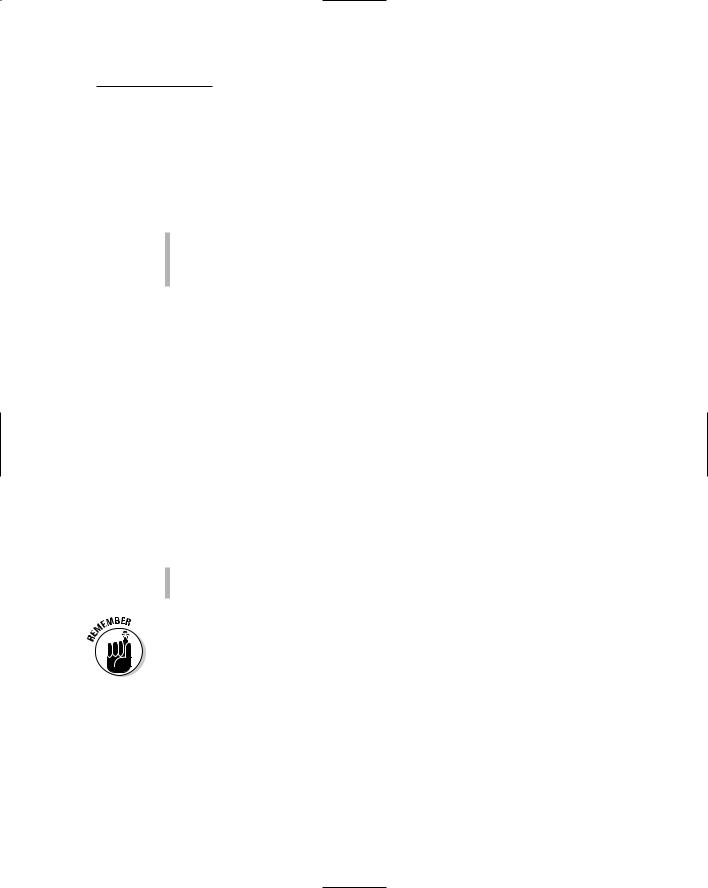
Chapter 3: ‘as-salaamu ‘alaykum!: Greetings and Introductions |
51 |
. . . I say goodbye
Saying goodbye in Arabic is a little more straightforward than greetings because, even though there are different ways of saying goodbye, they aren’t divided into formal or informal options. Here are the most common ways of saying goodbye in Arabic:
ma’a as-salaama (ma-a ass-sa-laa-ma; go with peace, or goodbye)
‘ilaa al-liqaa’ (ee-laa al-li-kaa; until next time)
‘ilaa al-ghad (ee-laa al-gad; see you tomorrow)
How are you doing?
After you’ve greeted someone by saying ‘ahlan wa sahlan or ‘as-salaamu ‘alaykum, the next part of an Arabic greeting is asking how the person’s doing.
The most common way of asking someone how he’s doing is kayf al-Haal? (ka-yef al-haal). When you break down the phrase, you discover that Haal means “health” and kayf means “how.” (The prefix al- attached to Haal is a definite article, so al-Haal means “the health.”) Therefore, the phrase kayf alHaal? literally means “How is the health?,” but for all intents and purposes, you can translate it into English as “How are you?”
kayf al-Haal is a gender-neutral phrase for asking people how they’re doing, but you should also be aware of gender-defined greeting terms, which are derivatives of the kayf al-Haal phrase:
When addressing a man, use kayf Haaluka (ka-yef haa-lou-ka).
When addressing a woman, use kayf Haaluki (ka-yef haa-lou-kee).
Another variation of kayf al-Haal is kayf Haalak? (ka-yef haa-lak; How is your health?). You can use either greeting, but kayf al-Haal is preferred when you’re meeting someone for the first time because kayf Haalak is a bit more personal and informal.
I’m doing well!
When someone asks you how you’re doing, if you’re doing just fine, the typical response is al-Hamdu li-llah (al-ham-dou lee-lah). al-Hamdu li-llah literally means “Praise to God,” but in this context, it translates to “I’m doing well.” Typically, after you say al-Hamdu li-llah, you follow up by saying shukran (shouk-ran; thank you). As you expose yourself to more and more
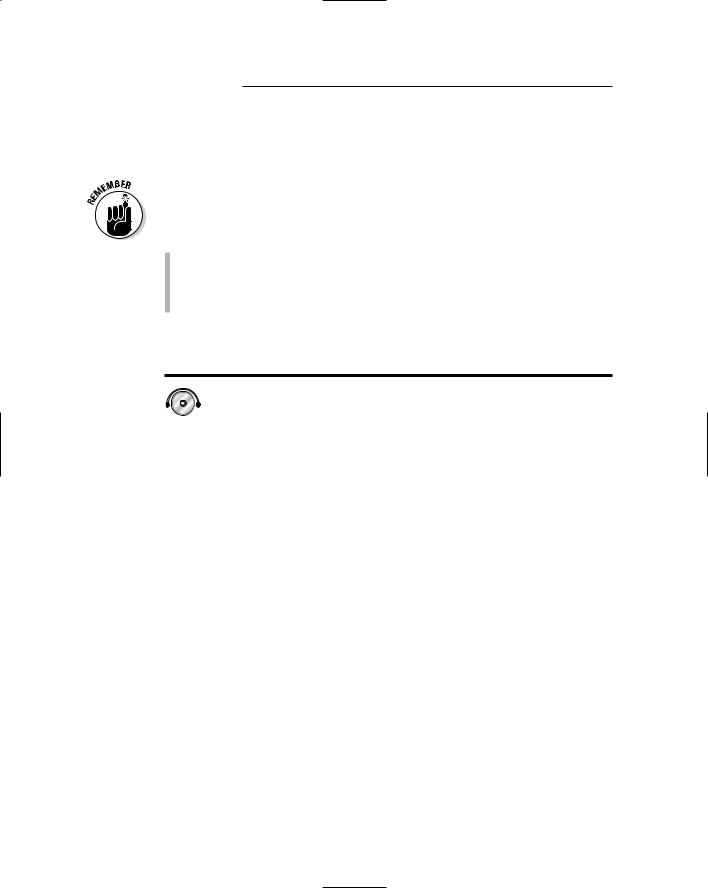
52 |
Part I: Getting Started |
Arabic phrases and terms, you’ll notice that the reference to Allah is widespread. Modern Arabic evolved from the Koran, and many everyday phrases still contain religious references. That’s why a phrase as mundane as “I’m doing well” takes on religious overtones.
A greeting wouldn’t be complete if both sides didn’t address each other. So after you say al-Hamdu li-llah, shukran, you need to ask the other person how he or she is doing:
If you’re speaking with a man, you say wa ‘anta kayf al-Haal (wa an-ta ka-yef al-haal; And you, how are you?).
If you’re speaking with a woman, you say wa ‘anti kayf al-Haal (wa antee ka-yef al-haal; And you, how are you?).
Talkin’ the Talk
Myriam and Lisa, who are both students at the university, greet each other at the school entrance.
Myriam: |
as-salaamu ‘alaykum! |
|
as-salaam-ou a-lai-koum! |
|
Hello! |
Lisa: |
wa ‘alaykum as-salaam! |
|
wah a-lai-koum as-salaam! |
|
Hello! |
Myriam: |
kayf al-Haal? |
|
ka-yef al-haal? |
|
How are you? |
Lisa: |
al-Hamdu li-llah, shukran. wa ‘anti, kayf al-Haal? |
|
al-ham-dou lee-lah, shouk-ran. wah an-tee, |
|
ka-yef al-haal? |
|
I’m doing well, thank you. And you, how are you? |
Myriam: |
al-Hamdu li-llah, shukran. |
|
al-ham-dou lee-lah, shouk-ran. |
|
I’m doing well, thank you! |
Lisa: |
‘ilaa al-ghad! |
|
ee-laa al-gad! |
|
I’ll see you tomorrow! |
Myriam: |
‘ilaa al-ghad! |
|
ee-laa al-gad! |
|
I’ll see you tomorrow! |
|
|
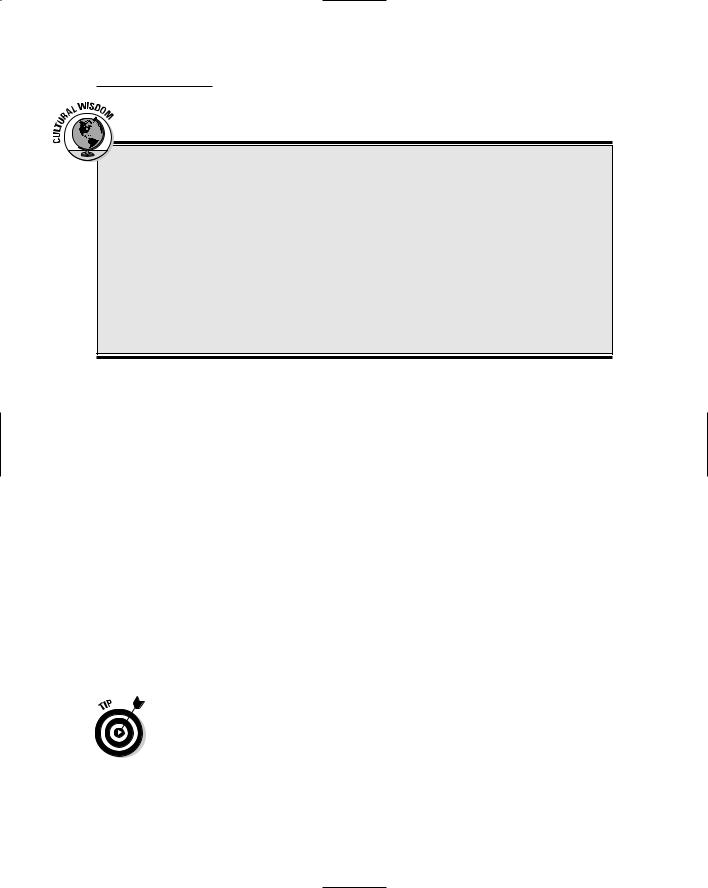
Chapter 3: ‘as-salaamu ‘alaykum!: Greetings and Introductions |
53 |
Sending the right nonverbal message
Although familiarizing yourself with the language is the first step to interacting with people from the Middle East, you also need to understand some of the nonverbal signs that can be as meaningful as words in communicating with native speakers. For example, when shaking someone’s hand, be sure to avoid pressing the person’s palm with too much force. In the United States, a firm and strong handshake is encouraged in order to display a healthy dose
of confidence. In most Arab countries, however, a forceful handshake is viewed as an openly hostile act! The reasoning is that you use force against people whom you don’t consider friends, so a forceful handshake indicates that you don’t consider that person a friend. Therefore, the most acceptable way to shake hands in the Arab world is to present a friendly, not-too-firm grip.
Making Introductions
Carrying on a conversation with someone you haven’t exchanged names with is awkward, to say the least. But it’s an awkwardness that’s easy enough to remedy when you know a few key phrases. This section explains how to ask people for their names and how to share your name using the possessive form, which may be one of the easiest grammar lessons and linguistic concepts you’ll encounter in Arabic!
Asking “What’s your name?”
After you go through the basic greeting procedure, which is covered in the preceding section, you’re ready to ask people their names. This task is relatively easy given that you only need to know two words: ‘ism (name) and maa (what). If you’re addressing a man, you ask maa ‘ismuka? (maa ees-moo-ka; What’s your name?) (M). When addressing a woman, you ask maa ‘ismuki? (maa ees-moo-kee; What’s your name?) (F).
If you say maa ‘ismuk without using the suffixes –a or –i at the end of ‘ismuk, you’re actually using a gender-neutral form, which is perfectly acceptable. You can address both men and women by saying maa ‘ismuk? (maa eesmook; What’s your name?) (GN).
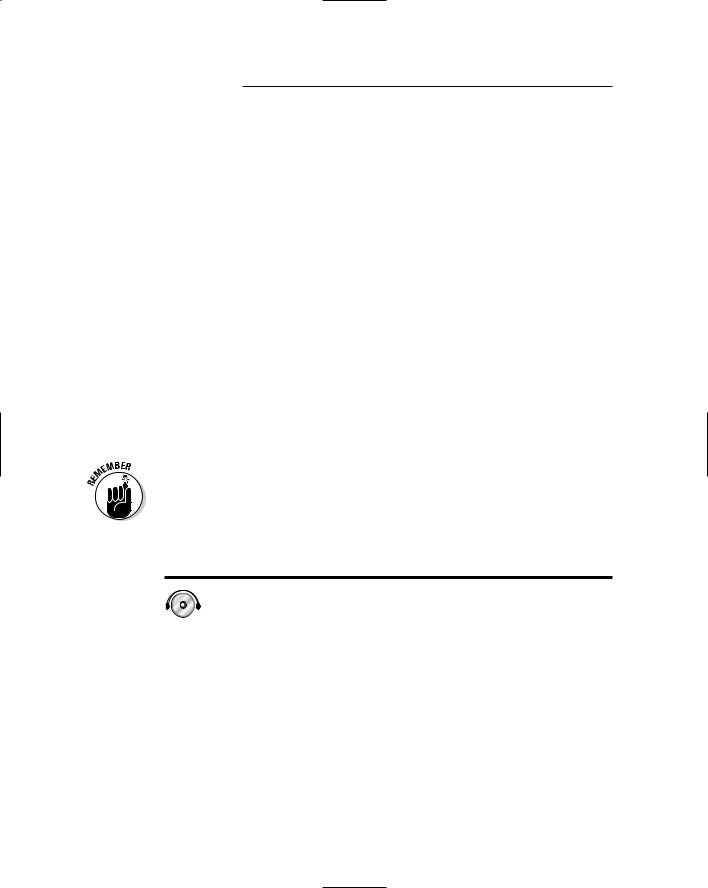
54 |
Part I: Getting Started |
Responding with the possessive “My name is . . .”
The possessive form is one of Arabic’s easiest grammatical lessons: All you do is add the suffix –ii (pronounced ee) to the noun, and — voila! — you have the possessive form of the noun. For example, to say “my name,” you add –ii to ‘ism and get ‘ismii (ees-mee; my name). So to say “My name is Amine,” all you say is ‘ismii amiin. It’s that simple!
Saying “It’s a pleasure to meet you!”
When someone introduces himself or herself, a polite response is tasharrafnaa. (tah-shah-raf-nah; It’s a pleasure to meet you.) tasharrafnaa is a formal response, whereas ‘ahlan wa sahlan (ahel-an wah sah-lan; Nice to meet you.) is much more informal.
sharafa is the Arabic term for “honor,” which means that tasharrafnaa literally translates to “We’re honored.” In English, it’s the equivalent of “It’s a pleasure to meet you.”
‘ahlan wa sahlan is a phrase with a dual role: When used at the beginning of a dialogue, it means “hi” (see the section “You say hello . . .” earlier in this chapter for further explanation). When used right after an introduction, you’re informally saying “Nice to meet you.”
Talkin’ the Talk
Amine walks into a coffee shop in downtown Casablanca and greets Alex.
Amine: |
‘ahlan wa sahlan! |
|
ahel-an wah sah-lan! |
|
Hi! |
Alex: |
‘ahlan wa sahlan! |
|
ahel-an wah sah-lan! |
|
Hi! |
Amine: |
‘ismii amiin. wa ‘anta, maa ismuka? |
|
ees-mee a-mii-n. wah an-ta maa ees-moo-ka? |
|
My name is Amine. And you, what’s your name? |
Alex: |
‘ismii aleks. |
|
ees-mee aleks. |
|
My name is Alex |

Chapter 3: ‘as-salaamu ‘alaykum!: Greetings and Introductions |
55 |
Amine: tasharrafnaa! tah-shah-raf-nah!
It’s a pleasure to meet you!
Alex: tasharrafnaa! tah-shah-raf-nah!
It’s a pleasure to meet you!
Talking About Countries
and Nationalities
With the growing internationalism of the modern world, when you meet someone for the first time, you may want to know what country he or she is from. Fortunately for English speakers, the names of countries in Arabic are very similar to their names in English. Even more good news is the fact that the terms for nationalities are derivatives of the country names.
Asking “Where are you from?”
If you’re speaking with a man and want to ask him where he’s from, you use the phrase min ‘ayna ‘anta (min ay-na ann-ta). Similarly, if you want to ask a woman “Where are you from?,” you say min ‘ayna ‘anti? (min ay-na ann-tee).
If you want to ask if a man is from a certain place — for example, America — you say hal ‘anta min ‘amriikaa? (hal ann-ta min am-ree-kaa; Are you from America?) (M). If you’re speaking with a woman, you simply replace ‘anta with ‘anti.
Telling where “I am from . . .”
To say “I am from . . .,” you use the preposition min (from) and the personal pronoun ‘anaa (I/me). Therefore, “I’m from America” is ‘anaa min ‘amriikaa. It’s that simple!
To help you both understand responses to the question “Where are you from?” (see the preceding section) and give your own response to such questions, Table 3-1 lists the names of various countries and corresponding nationalities in Arabic.
